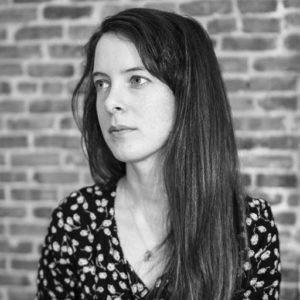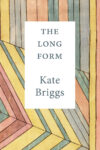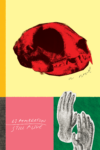 “When I started I was thinking of that idea (I’m not going to remember whose idea it is) that there are only so many plots in all of literature, and one of them is “a stranger comes to town.” I wanted to write one of those.” In Relief Map, the debut novel from Rosalie Knecht, the stranger in question is Revaz, a Chechen attempting to flee his past problems only to find new ones in America as he becomes the target of an extensive manhunt. The town in question is Lomath, Pennsylvania, nestled deep in a valley and seemingly secure from the fear and paranoia of the global terrorist sort. At once a portrait of place and of our times, and in particular what it means to imagine a future from a place of social exclusion, Relief Map patiently unfolds its narrative through Livy, a 16-year old resident thrown back on her own nascent awareness of the the ways of the world in this exceptional circumstance, and Revaz in his desperate search for safety.
“When I started I was thinking of that idea (I’m not going to remember whose idea it is) that there are only so many plots in all of literature, and one of them is “a stranger comes to town.” I wanted to write one of those.” In Relief Map, the debut novel from Rosalie Knecht, the stranger in question is Revaz, a Chechen attempting to flee his past problems only to find new ones in America as he becomes the target of an extensive manhunt. The town in question is Lomath, Pennsylvania, nestled deep in a valley and seemingly secure from the fear and paranoia of the global terrorist sort. At once a portrait of place and of our times, and in particular what it means to imagine a future from a place of social exclusion, Relief Map patiently unfolds its narrative through Livy, a 16-year old resident thrown back on her own nascent awareness of the the ways of the world in this exceptional circumstance, and Revaz in his desperate search for safety.
Over email I asked Rosalie what details help a writer capture a place like Lomath, how her job as a social worker has informed her appreciation of writing in different registers, and the challenges that come with writing the contemporary coming of age story. You can read a review of Relief Map in these pages, as the NYRB would say, here.
Michael Schapira: You began writing the book before the Boston Marathon bombing [am I right in this?]. The spectacle of a city-wide lock down (coincidentally looking for people from the same general region as Revaz, the subject of the manhunt in the book) gives a new resonance to what might in a different time have been a useful literary conceit. Would you agree with the idea that, even in this small town, terrorism, and all that comes along with it, is more atmospheric than allegorical?
Rosalie Knecht: Yes, I was writing this before the Boston Marathon bombing happened, and at the time I remember feeling that the shutdown of Boston was deeply surreal and made slightly more so for me personally by the fact that I had been trying to imagine what a shutdown would feel like for a few years. And of course I was startled when they turned out to be Chechen. There was the whole racial confusion that seemed to come out of that, as people were trying to locate Chechnya in a racial framework and being flummoxed by the notion of white Muslims. Part of the reason I made Revaz a Chechen in my book was that I wanted people in Lomath to be confused in that way about him.
I’m not sure what you mean by atmospheric vs allegorical, but I will say that I didn’t intend the War on Terror parts of the plot to be allegorical. I am a pretty literal writer, plot-wise. Although…when I started I was thinking of that idea (I’m not going to remember whose idea it is) that there are only so many plots in all of literature, and one of them is “a stranger comes to town.” I wanted to write one of those.
At a reading you mentioned that you started writing Relief Map when you were very far away from home. But really you were writing from two distances, one geographical and one temporal [Livy, one of the two protagonists, is 16]. Was this place and this age something you’d been interested in exploring for some time? If so was this kind of distance, which is something that you kind of have to experience and can’t replicate in a writing seminar or an environment that is similar to rural Pennsylvania, a useful way to finally get at some of the major themes in the book?
Yes, I was in Argentina when I started writing Relief Map. The distance was intense and on top of being geographic it was also linguistic. I rarely had conversations in English during that time because I was in a small city six hours from Buenos Aires. I only knew one native English speaker and she lived across town. So I was isolated and felt like I was forgetting how to speak my own language. Actually, “speakenglish.doc” was the original title of the file.
It’s interesting you say there’s a temporal distance between me and Livy. There certainly is now (I’m 31 and Livy is 16), but when I started writing the book I was 22, which meant that 16 was only just far enough behind me for me to feel I had a little perspective on it, but not so far that I had a lot of different stages of life to choose from. I’d been an adolescent for fifty years and an adult for about ten minutes.
And I missed the valley I’d grown up in. Absence makes the heart grow fonder. And the valley has a self-contained quality I wanted to write about.
I grew up in a small town and my family has roots in western Pennsylvania, and for these and other reasons (e.g. the fact that the young people in the book were always outside and often involved in some low level criminal activity) Lomath felt very familiar to me. What were the most important details that you thought were necessary to convey the feeling of a town like Lomath and what it might be like to live there?
I wanted people to feel the topography of it, because there is something about a valley—it hides, then reveals. And almost always there is water at the bottom, which connects it to other places even if those places seem worlds away. My therapist once said a creek is like a book. In one dimension, it’s small. In another dimension, it’s very large, maybe infinite.
On the social level, I wanted to depict people who are middle class and working class and poor, and maybe haven’t gotten around to replacing a broken window or clearing all the shit off the porch, and maybe some of the native sons are in jail and some are in college. That mix. The default world of literary fiction is a very professional class, with occasional sprinkles of They Closed the Mill and Now We’re All on OxyContin. I wanted to be more matter of fact about post-industrial small town life. Some people are on OxyContin! And some are doing okay. And everybody’s kids are smoking weed in the woods.
Livy has a pretty good relationship with her parents, who seem like well-intentioned baby boomers, but over the course of the book it gets strained because there is some disagreement on how truthful they expect one another to be. There are in fact a wide variety of parenting styles in the book (overbearing, absent). Can you say a little more about how these generational conflicts fit into capturing a town like Lomath?
In Lomath, I think the adults feel that the kids are somewhat out of control. The parents are mostly battening down the hatches and waiting for adolescence to be over. Maybe in a place like Lomath there are more parents who have wild adolescences of their own to remember, so they have a more realistic (or fatalistic?) sense of how much control is really possible.
I don’t know what you think of calling your book a coming of age story, but would you be comfortable including it in a more specific genre of coming of age in an age of misinformation story? Does this make sense as a distinct genre?
Sure, I’d be comfortable with that! I thought it was important that Livy be struggling to make moral choices both because she would rather make safe choices (as would most of us) and because she doesn’t even have enough information to know for sure what the moral choice would be. In a basic way, all she can work with is the information directly in front of her, which is that this person is helpless and seems scared. That’s really all she has to go on.
The idea of it as a genre is interesting, because if I think about misinformation and “official” information and plot being constructed around those discrepancies, then we’re talking about spy novels.
You are a social worker, and wrote about how this relates to fiction recently on LitHub. In fact you wrote about how your writerly sensibilities found the use of pronouns in official case notes interesting. Have you ever been tempted to take up any literary projects in this professional voice, as a way to explore a new language a little more?
I work with adolescents in foster care, and I’ve noticed that the more intense and meaningful a conversation with one of my clients is, the more sterile the note is. I probably write variations of this note several times per month: “This writer met with the youth to discuss his family relationships, social relationships, and emotional management.” What’s going unsaid is all the stuff that makes the job worthwhile– the turns of phrase, the specificity of their particular struggles with other people, the girl they like, the quirks of an identity developing under intense pressure.
So the notes are weird and sterile, and pitched to the needs of a bureaucracy that tries to be as much like a machine as possible. But they are still a narrative. They’re actually REQUIRED to be a narrative. Auditors come and complain about how we’re not making them narrative enough. So yeah, I could see the temptation to do something with fiction in that form, the way George Saunders repurposes corporate speak to let this wild stuff show through.
To give us some insight into your profession, are you happy with the theoretical paradigms (setting aside bureaucratic issues) in which social workers are currently trained?
*whirring and screeching noises as I set aside bureaucratic issues* Actually, yes? Social work education is some heavily postmodern shit. It has to be, because most social work jobs are a mix of therapy and helping people access services, and both of those things involve being in touch on a very concrete level with the fact that the truth is multiply constructed and our lives are governed by systems that are drenched in ideology. If you’re not aware of that day to day and you’re doing this kind of work, you will lose your mind.
Do you have any favorite Rust Belt writers? Regional writers in general?
I love Denis Johnson, who I think probably qualifies as a rust belt writer, among other things, and Rebecca Curtis. If I can argue that north Jersey is rust belt, then I will throw Junot Diaz in there as well for his early stories. Dan Chaon in the west and Midwest. I’ve noticed that English writers are sharper about money and landscape — Zadie Smith and Tessa Hadley.
This is not a fully articulated question (in fact it would probably be thrown out of court as a leading question), but what you said about literary fiction being so closely associated with the professional class (as readers, writers, intermediaries like media, publishers, and agents; in subject matter and sensibilities) struck me as an important point. There have been similar studies of the lack of socio-economic diversity, or diversity of background and life experiences, in journalism. Thomas Frank makes a similar (if not simplistic) case in a recent book where he puts the betrayal of liberalism, and its associated focus on the working class, at the feet of the professional class. Do you think that now more than ever a frank conversation or depiction of how stratified America is experienced from different class positions is needed? Or put another way, if you magically were granted some privilege or power over the literary sphere, would you make this a priority?
There is still a sense that really “high status” literature describes an affluent world that very few people live in, and that can be alienating: the John Cheever, Alan Hollinghurst, Claire Messud stuff (I’m not saying that any of these are bad writers). But that being said, it is still easier to find a depiction of white working-class or poor life in literary fiction than a depiction of Black life at any socioeconomic level. Your John Cheever types may be dominating the canon, but your Raymond Carvers are right behind them, doing okay. Where is everybody else? Even when you can see some class diversity, other kinds of diversity are seriously lacking.
But to answer your question, yes, I think economic stratification is one of the primary problems in front of us now, and the more people talk about it, the better.
Are you finished with these characters? Would you ever want to track them Louis Malle style?
I think I’m finished with them. I spent eight years with them. We’ll see.
Michael Schapira is the Interviews editor at Full Stop and teaches Philosophy at Hofstra University.
This post may contain affiliate links.







